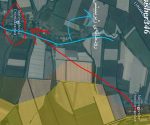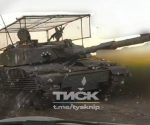The continuing grind at Kupyansk sees the Ukrainians expend that “third army” intended for the “Spring Offensive”
The headline Russian activity in the Special Military Operation at the moment has to be that which is unfolding around Avdeevka. If this is purposed to take the town then it signals, as per a pattern that has emerged, that the Russians feel that they are not to be surprised any longer by Ukrainian initiatives in the course of staging their own offensives. If Putin recently described these as “active defences”, it doesn’t change their real nature – a thing confirmed if the Ukrainians are counter-attacking them, which is a feature of the way that they defend.
This was discussed at length in a previous FBEL article, The Kupyansk And Krasny Liman Directions, July And August 2023, where it was also explained that the end of Ukrainian counter-attacking in Soledar and other settlements around Artyomovsk suggested an end to Ukrainian ability to defend at that place. Undisrupted Russian attacks at days on end then appear to have translated into actual territorial gains. It was said that this is what we should expect to see at Kupyansk.
And indeed, an end of Ukrainian counter-attacking, and then weeks of unhindered Russian attack is what we have seen across September and October, with the Ukrainians evidently having to reinforce – with forces that otherwise should have been involved in the (delayed) “Spring Offensive” – in order to regain strength in order to stage (what they see as) an effective defence. The following paragraph from said previous article is therefore especially prescient.
So, if the Russians are looking to close to the banks of the Oskil through the eastern part of Kupyansk – which is what the author thinks is the intention – we should suppose by their proven capability that they will do it. The Ukrainians will simply have their defensive wherewithal ground down. Indeed, there is a story doing the rounds – carried by no less than The New York Times – that the Ukrainian general Syrsky has felt the need to divert reserves to the Kupyansk direction against American advice. While there is no need to believe that the story or any of its elements are true, it is reasonable to believe that the Ukrainian defence will inevitably collapse.
If one wants to see the Ukrainians suffering yet another terrible setback typical according to their general performance (and one that directly affects the same), one isn’t going to do that when it comes from the Voenkors (wankers), or the OSINT-mongers – and they are all over Avdeevka in the same way they were all over Artyomovsk. One must, rather, look at the quiet reporting of the Russian Ministry of Defence in its daily briefings, over a long period, as it pertains to the Kupyansk direction.
To establish a picture, observe what Sergei Shoigu, Russian general and Minister of Defence, said on 26th September at the Defence Ministry Extended Board session
I would like to start with the situation in the military special operations zone.
Russian forces groups are actively engaged in defeating the enemy.
Thanks to the professionalism and courage of the personnel of the 25th and 138th Motorized Rifle Brigades in the direction of Kupyansk, Russian troops significantly expanded the control zone in the vicinity of Sinkovka and Petropavlovka.
Please note the date well, for it falls in the midst of the period that the author has been monitoring Russian MoD briefings in connection with activity in the Kupyansk direction, to wit: 17th September to 19th October. More importantly, it falls within a subset of 19 days to 5th October where there was no mention of Ukrainian counter attacking, but only the telling of Russian attacks. It can be inferred, given that Ukrainian defensive capability was non-apparent, and that Russia was able to attack without disruption, that the Russians were gaining position on the battlefield in the exact way that Shoigu was talking about.
We can also understand what the Russians were doing by the Ukrainian casualty count for the period 17th September to 5th October: 725 deaths, and a much smaller amount than that generated in the following period of 15 days to 19th October by the Ukrainians coming off the worst in the course of their mobile warfare: 1560.
Having established a more than adequate sketched illustration of what has been happening in the Kupyansk direction over the course of the previous month, we now take account of the details by which this report can be made.
From 17th to 24th September, the Russian briefings told of how Russian forces were attacking elements of 5 mechanised brigades, 2 airborne brigades, and 3 territorial defence brigades (TDBs).
Of the two airborne brigades, one – the 95th – might have been rotated out of the area at the beginning of this period, because it doesn’t appear again in the briefings until this past week. Something similar can be said for one of the TBDs. This means that, in the specified period, the Russians had regularly been attacking the following Ukrainian formations in the Kupyansk direction: the 14th, 30th, 32nd, 92nd, and 115th mechanised brigades, the 25th airborne brigade, and the 103rd and 113th TDBs. We should allow this to be a rough indicator of the scale of the defensive force in the Kupyansk direction at that time.
Regarding the characteristics of these components of this core defensive force, there is much to be known. The 32nd mech. Brigade was being newly formed in February, 2023, and supposedly took part in the “Spring Offensive” – i.e., the large scale operation pre-heralded as taking part in the springtime, but belatedly launched in June, and which expired (without being too accurate about it) at some time in the months of August and September. David Axe of Forbes wrote about this brigade on July 5th to report how it had indeed been formed specifically for the “Spring Offensive”, but had actually been deployed in Svatovo in Lugansk – which is outside the bounds of the line on which the Ukrainian initiative would take place. Axe would also complain about the 32nd having been downgraded so as not to be constituted (as intended) of American and Czech armour, and wrote:
All that is to say, it’s not clear exactly how mechanized the 32nd Mechanized Brigade really is—and how well-equipped it is for intensive counteroffensive operations.
Perhaps it was for the sake of misdirection that Axe went on to write, in a September 6th article, of the 32nd being in the “Vremievsky salient” sector of the South Donetsk direction, albeit exhausted, because, as it happens, the Russians start to report of this brigade being active in the Kupyansk direction at the end of July. As such, the story is told of a new brigade intended for the “big push” on its inception, but that featured in a new plan – which involved its very configuration – to hold the line at Kupyansk.
The 14th, 30th and 92nd and the 115th mechanised brigades are older.
Dealing with the latter most first, according to David Axe, this brigade was uncommitted to a front line in any theatre as late as August 18th. His concern was that the “Spring Offensive” would run out of steam if the 115th, and four other brigades-in-reserve, did not join the fight. With the last time Axe had heard anything of this body of men being in November, 2022, he would ask
Nine months later, it’s fair to say Ukraine needs every brigade it can mobilize. So where is the 115th Mechanized?
If Axe had read the Russian MoD briefings of the month prior to his article, he would have seen accounts of the 115th in the Donetsk direction, apparently being in the area of the “Spring Offensive” as it pertained to its northern-most extent. Later in August, the Russians would report of the 115th being in the Kupyansk direction.
Likewise, the 30th mechanised brigade, having been present at the unsuccessful defence of Artyomovsk, is given a one line credit – involving no detail – by Wikipedia as having taken part in the “Spring Offensive”. One begins to suppose, if this is true, that the 30th might have been in the Donetsk direction, since there is no hint to be found of this brigade being anywhere else.
The 92nd, with its “training courtesy of British advisors”, is – or at least was – one of David Axe’s favourites. In February 2022, before the start of the SMO, he wrote about it as “one Of Ukraine’s best brigades defend[ing] one of its most vulnerable cities” – meaning Kharkov.
Having taken part, in 2022, in the Russian artillery riddled drive across that oblast after which the “Kharkov counteroffensive” is named, the 92nd had seemingly been suffering somewhere (or at various places) on what is hereabouts dubbed the “Torskoye-Dvurechnoye line” (northern Donetsk to north of Kupyasnk). In a statement without supporting evidence, Wikipedia claims that “the brigade was reflagged as an assault infantry formation in 2023”.
Like the 92nd, the 14th mech. brigade took part in following the Russian withdrawal from Kharkov, and appears to have been stationed in the same part of the world ever since.
Within this bunch of mechanised brigades, then, at least one had most probably been diverted from the “Spring Offensive”. Another had also very likely been similarly repurposed. Moreover, there is an overall question mark about the quality about this defensive force in relation to its being in the very theatre out of which the Ukrainians could not extend their big push, happening all along the line elsewhere – but with the point of this article being about the redirection of Ukrainian forces from an attacking posture to a defensive one so as to spoil a grand plan to reach Mariupol and Melitopol, and perhaps even to retake Artyomovsk, this is perhaps beyond our scope, even if it remains entirely relevant.
With the Ukrainians evidently not having the numbers to stage a defence (according to their Western manoeuvre warfare doctrine), with only 8 units comprising of reservists (the TDBs), along with brigades deemed not shock enough for the “Spring Offensive”, or else to be gambled on as not to be missed so they can be disengaged and redeployed,, it’s perhaps not a coincidence that the Russians MoD briefings started to report new names in the Ukrainian ranks on and from the 25th September – the day before Shoigu presented news of Russian success at Kupyansk.
The first of these was the 43rd and 66th mechanised brigades. Later, on 2nd October, came mention of the 44th mechanised brigade, and the 107th TDB. This was not the end. On 7th October the Russians started talking about the 4th Tank Brigade and the 115th TDB; 11th October, the 10th mountain assault brigade; 14th October, the 68th Jaeger brigade; 16th October, the 112th TBD.
The Ukrainian counter attacks – or tell of them by the Russians – resumed on 6th/7th October. Until the 10th, they were carried out by the 4th Tank Brigade (thrice) and the 32nd (twice), 44th (once), 66th (twice), and 115th (twice) mechanised brigades. In the briefing for the 11th October, the 10th mountaineers joined the 32nd and the 115th, and haven’t been heard of since.
From the 12th October, and thereafter until the time of writing, Ukrainian counterattacks in the Kupyansk direction were executed by the 4th Tank Brigade (once), and the 14th (quince), 32nd (quince), 43rd (twice), 44th (once) and 115th (sence) mechanised brigades, and also the 68th jaegers (quadrice), and the 95th airborne (twice).
What this meant for the scale of the Ukrainian forces and ability to defend from the 6th/7th to the time of writing can loosely be visualised as follows. Taking into account (the author suspects) the possible rotation out of the front of the 30th mechanised and one of the TBDs, to and including the 13th October, the Ukrainians had enjoyed the net addition of two mech. brigades, a tank brigade, a mountain brigade, and one TBD to their defensive forces. The total, therefore, was 15 brigades. So, what is being suggested is that the necessary purchase to begin counter attacking was gained by the addition of 7 brigades.
From the 14th onwards, with the two new territorial and mechanised brigades being mentioned in briefings, and the 95th airborne also being rotated to the front, but with – as the author suspects – the 66th and 92nd mech. and 25th airborne brigades being ineffective (giving the 10th mountain assault brigade the benefit of the doubt), the Ukrainians managed to maintain at least 15 brigades in defence (with like for like swaps, if the 92nd is now an infantry brigade) – and maintain their counter attacking defensive capability.
Notably, however, the 4th Tank Brigade soon did not feature in the reports after the 12th October, and in actual fact, given that the Russians claim to have destroyed 2 Leopard tanks in the theatre on 22nd September, and given that the reservist (“fat and olds” of the) 4th Tank Brigade famously took first delivery from Poland of 4 of these tanks in February 2023, it’s a good bet that this brigade has been coddled behind the lines (where it still couldn’t escape being targeted), and only taken out from cover as a last resort. It is perhaps in accordance with this policy that the burden of counter attacking defence had been taken up by the 68th jaegers, and the 14th, 32nd, 115th mech. brigades in the last week. Also, an apparent acceleration in the rate of counter attacking has resulted in an inflated cost that these brigades have evidently been more tolerant of than the newer, and seemingly newly arrived (or rotated in) 43rd and 44th mech. brigades.
A word must be said about these before there is a discussion of the Ukrainian counter attacks pertaining to their rate and results. The 43rd mechanised brigade was in formation as of April 2023. The 44th was in training in Poland even as David Axe of Forbes was writing of it in August, and wondering if a battalion had been deployed “to northeastern Ukraine, where the Russian army has launched a countercounteroffensive”. Just as he did with the 115th mechanised brigade, Forbes, in the same article, seemed to think that an uncommitted 44th should have been taking part in the “Spring Offensive”. It stands to reason, judging even from the evidence presented here, that the 43rd also had been conceived as a component part of the same grand initiative. So it is very significant indeed that there’s a good possibility that the great glut of infantry fighting vehicles destroyed by the Russians in one week, as the reader is about to see, are the BMP-1s belonging the fatally inexperienced 43rd and 44th.
In the week of the 7th to 13th, the Ukrainians staged 40 counter attacks. In the week of the 14th to 20th it was 54. Casualties were respectively as follows: 790 killed, 3 tanks and 2 armoured fighting vehicles (AFVs) lost; 770 killed, 9 tanks, 19 AFVs (plus an American made M113 armoured personnel carrier) and 2 infantry fighting vehicles. Indeed, David Axe of Forbes, when complaining on behalf of the 32nd mechanised brigade, talks about it having a mixture of American personnel carriers and Ukrainian T-64 tanks.
Apart from the previous paragraph telling a tale of brigades that should have taken part in the “Spring Offensive” being obliterated in a fraught effort to stop the Russians advancing to the Oskil River, it also suggests the awful danger at hand for the Ukrainians as they hurry up (for reasons that don’t have to be explored here) towards another period of static helplessness.
There are analysts out there – pundits who are considered experts – who say that there are between 20 and 30 brigades worth of Ukrainian soldiery and equipment in the Kupyansk direction that mostly sits in front line trenches, acting as a holding force, while elite troops pop out of from sheltered areas in the rear to attempt to recapture lost territory, and that the Russians must move trepidatiously against this permutation of their adversary just from the pure vastness of it.
It isn’t so. The Russians clearly have to deal with a defence that manifests as counter attacking – which is designed to disrupt their own offensive manoeuvres. The Russians have to deal with this all the while the Ukrainians are capable of producing it. Only after that will they face a static defence (again, as far as this direction goes) whose flaw is that it is too small to manoeuvre (not too small to fill up lines of trenches). At this point, the time it takes to break the Ukrainians will surely depend on how the Russians want to engage (involving how many casualties they want to suffer) – but the bottom line is that the Russians’ superiority in stand-off fire will mean that the Ukrainians’ days holding off a Russian advance will be nothing else but numbered.
The only other factor affecting the length of the timeline is the ability of the Ukrainians to reinforce, and therefore be able to defend according to doctrine – which we now know has lately been done to the detriment of a watershed operation, and push to the Black Sea, that was meant to change the dynamics of the conflict. It stands to reason, then, that if the Russians have already forced this amount of sacrifice, then it is very difficult to visualise where else the Ukrainians can draw from. Nothing else signifies a catastrophic lack of reserve than having to forego being able to achieve the main strategic objective of a war by being tactically deficient for want of the necessary forces, that have otherwise been sent to another theatre, there to be obliterated. It will be fascinating to see how the Ukrainian defeat in the Kupyansk direction will play out, and what it will look like. In terms of the former, the author can only predict that at some point there will be manoeuvre warfare in the name of defence all carried out in motor cars and on foot, and in terms of the latter, he can only imagine that, given the Russian border with Kharkov, a retreat to behind the Oskil will not necessarily save the Ukrainians from the bad public relations spectacle of a mass surrender.
Update, 22/10/23:
In today’s Russian MoD briefing we find the 41st mechanised brigade cropping up and being described as taking part in a mere 3 attacks (along with the 68th Jaegers, only). A search reveals that the 41st mechanised was active in the same way in the Kupyansk direction in the middle of August – along with the 67th mech. brigade (of DaVinci Wolves infamy), which at this time is fighting “mostly defensive action against Russian attacks around Kreminna [sic]”, according to David Axe (agreed upon by the Russian MoD) . In July, Axe suggested that the 41st was a new brigade, and indeed, Wikipedia has no history for it.
It’s quite possible (from the data that can, and also cannot be gathered) that the Kupyansk direction could have been the theatre of the 41st’s initial deployment, and that it spent a long time in the rear after what could have been its first action in August.
The other thing to note from today’s briefing for Kupyansk is this:
Up to 15 servicemen, two armoured fighting vehicles, and three motor vehicles have been neutralised.


















